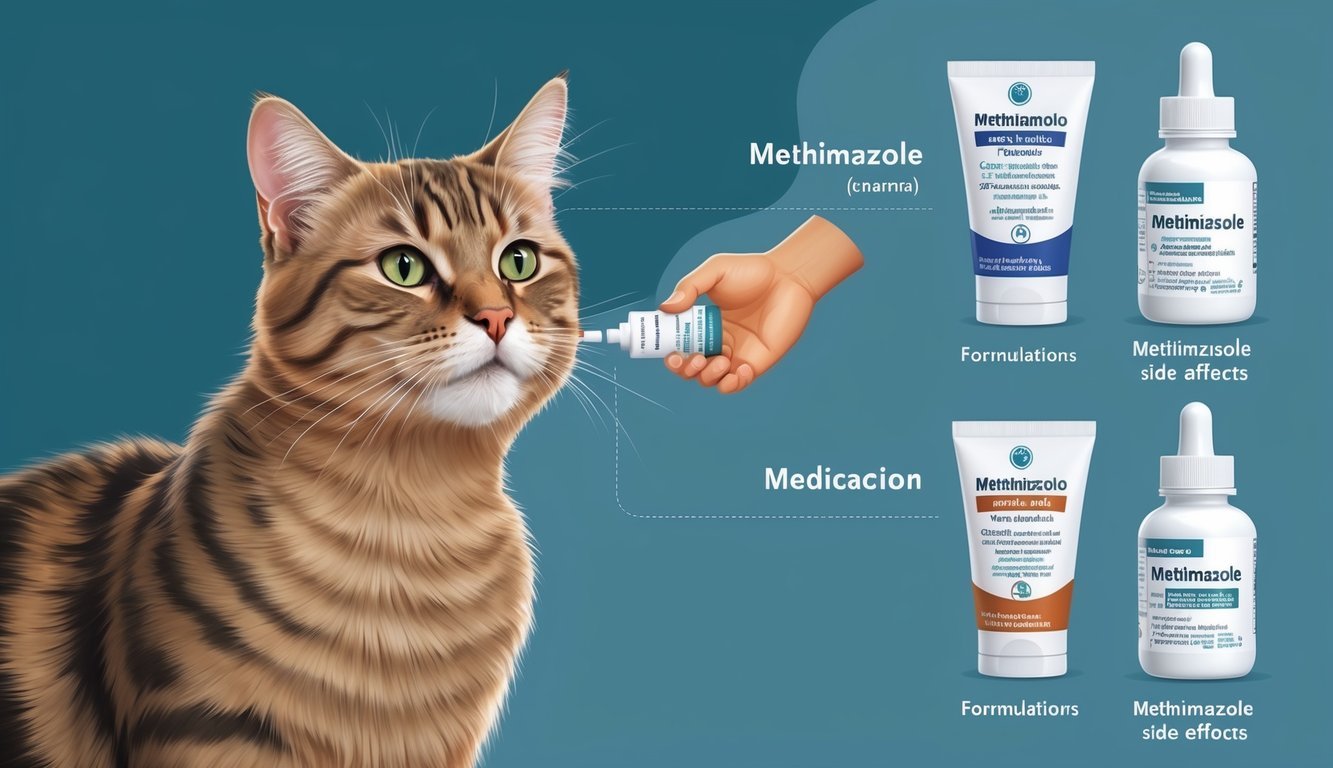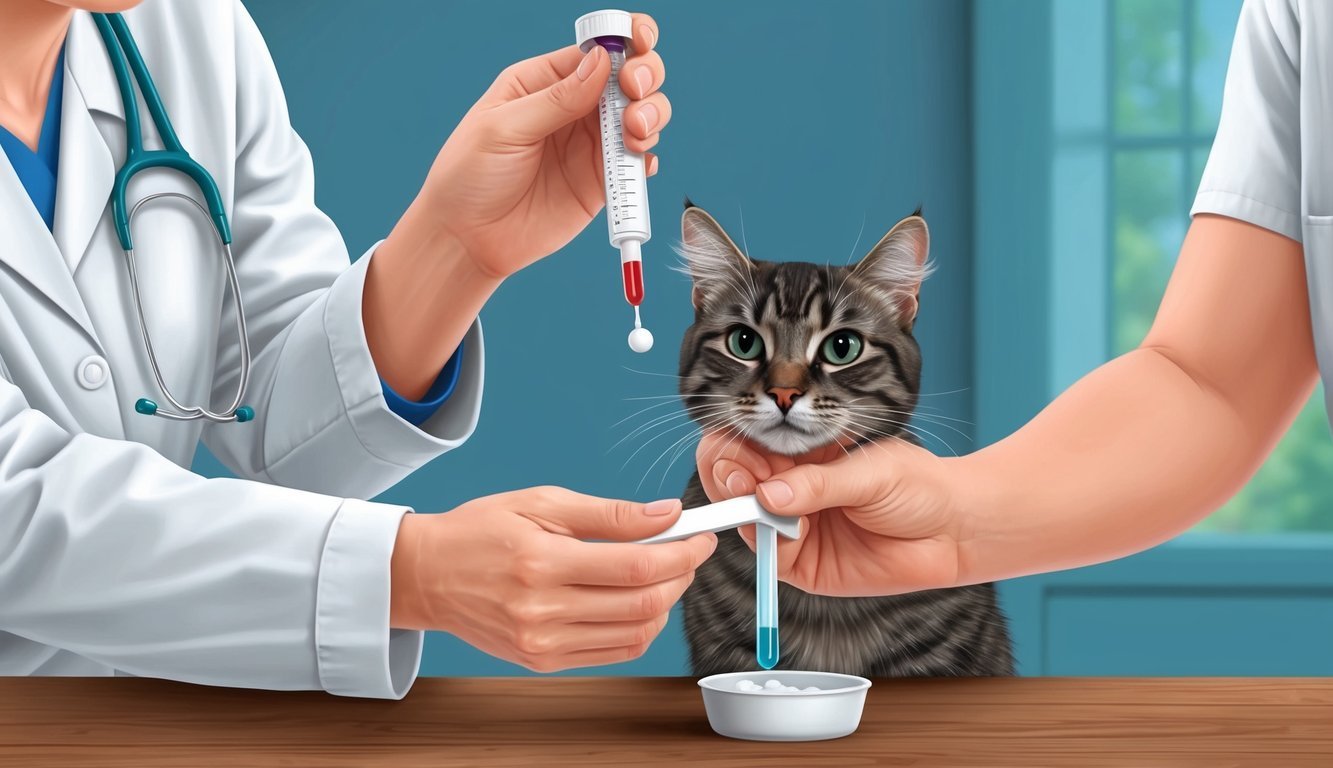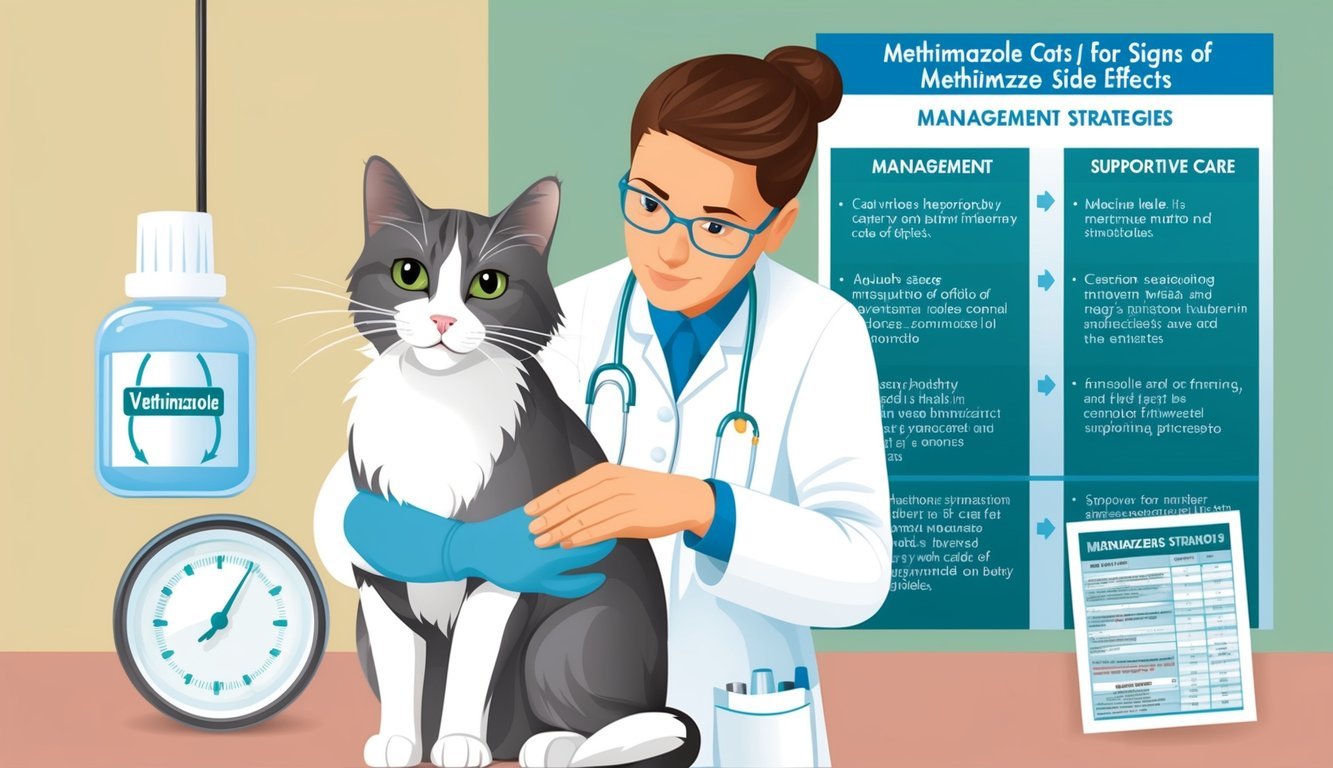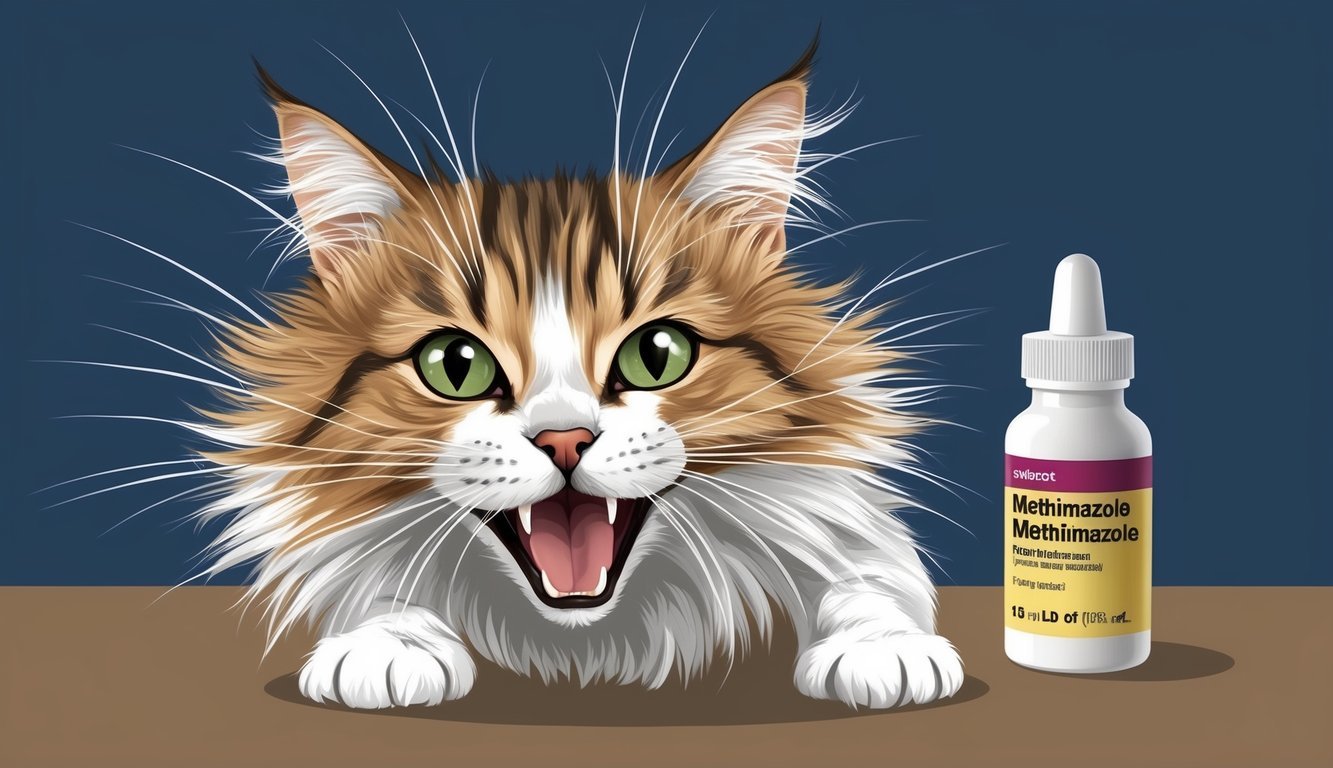Many veterinarians prescribe methimazole, an effective antithyroid medication, when treating hyperthyroidism in cats.
While it can significantly improve your cat’s health, you should also be aware of the potential side effects that can arise from its use.
Understanding what to expect can help you monitor your feline friend closely and ensure they remain comfortable during treatment.
Methimazole is generally well-tolerated, but some cats may experience gastrointestinal issues, skin reactions, or even blood abnormalities.
Knowing these possible reactions can empower you to act swiftly if your cat shows signs of discomfort or adverse effects, making it easier to communicate with your veterinarian.
By being informed about methimazole’s side effects and how to manage them, you can provide better care for your beloved pet.
This article will explore common and serious side effects, along with tips on medication administration and when to seek veterinary advice.
Key Takeaways
- Methimazole is commonly prescribed for hyperthyroidism in cats.
- Knowing potential side effects can help in monitoring your cat’s wellbeing.
- Consult your veterinarian if you observe any unusual reactions after medication.
Understanding Methimazole

Methimazole is an antithyroid medication commonly prescribed for cats with hyperthyroidism.
This condition occurs when the thyroid gland produces excess thyroid hormones, mainly T3 and T4.
By inhibiting thyroid peroxidase, methimazole effectively blocks the synthesis of these hormones.
This helps to manage hyperthyroidism without curing it.
You may encounter methimazole under brand names like Tapazole or Felimazole.
The formulation typically comes in oral tablets, available in dosages of 2.5 mg and 5 mg.
While many cats tolerate methimazole well, side effects can occur.
Common issues include:
- Vomiting
- Loss of appetite
- Lethargy
These effects often appear within the first three months of treatment.
About 10% of cats may experience gastrointestinal upset.
It’s important to monitor your cat’s response to the medication closely.
Regular veterinary check-ups can help manage side effects and adjust the dosage if needed.
Methimazole serves as a valuable option in managing feline hyperthyroidism, allowing your cat to lead a healthier life despite requiring ongoing treatment.
The Role of Methimazole in Managing Feline Hyperthyroidism
Methimazole plays a crucial role in treating feline hyperthyroidism by addressing elevated thyroid hormone levels, which can lead to various health issues in your cat.
Understanding how it works, when to choose it, and how it compares to other treatment options is essential for making informed decisions.
How Methimazole Works
Methimazole functions by blocking thyroid peroxidase, an enzyme essential in the synthesis of thyroid hormones.
This action inhibits the production of thyroxine (T4) and triiodothyronine (T3), which are often overproduced in hyperthyroid cats.
The medication allows the thyroid gland to regulate hormone levels more effectively.
Most cats respond well, and monitoring thyroid hormone levels will help ensure the medication is doing its job.
Choosing Methimazole for Treatment
When deciding on a treatment for your cat’s hyperthyroidism, methimazole is often the first choice.
It is generally well-tolerated and presents fewer side effects than older medications.
Your veterinarian will likely recommend starting with this option due to its efficacy.
Regular blood tests should be scheduled to monitor your cat’s thyroid hormone levels and adjust the dosage as needed to optimize treatment.
Comparing Treatment Options
You have several options for treating feline hyperthyroidism, and it is important to consider each one.
Methimazole is not the only choice; alternatives include:
- Radioiodine treatment: Permanently destroys overactive thyroid tissue.
- Surgery: Involves removing the thyroid gland but carries surgical risks.
Each option has its pros and cons, and the best choice depends on your cat’s health, age, and response to treatment.
Discussing these options with your veterinarian can ensure you select the most effective approach for your cat’s needs.
Common Side Effects of Methimazole

When treating your cat with methimazole, it’s important to be aware of certain side effects that may arise.
Understanding these reactions can help you monitor your pet’s health effectively.
Gastrointestinal Upset
One of the most frequent side effects of methimazole is gastrointestinal upset.
You might notice your cat experiencing vomiting, diarrhea, or a decrease in appetite, also known as anorexia.
These symptoms typically occur within the first few weeks of treatment.
If your cat is feeling nauseous, you may observe them avoiding food or becoming lethargic.
It’s crucial to ensure they stay hydrated.
In some cases, gastrointestinal symptoms can resolve on their own after a few days.
However, if symptoms persist, consult your veterinarian for guidance.
They may recommend adjustments to the medication or dietary changes.
Skin Reactions
Skin reactions can also occur with methimazole treatment.
These may manifest as irritations, rashes, or eruptions on your cat’s skin.
While less common, these reactions might lead to discomfort and scratching.
In more serious cases, methimazole can cause a condition known as immune-mediated anemia, where the body’s immune system mistakenly attacks red blood cells.
If you notice any significant changes in your cat’s skin or behavior, it’s a good idea to reach out to your vet for evaluation and support.
Effects on Blood Cell Counts
Methimazole can occasionally affect your cat’s blood cell counts.
Monitoring for blood disorders is essential, as adverse events might lead to issues such as anemia.
Symptoms of anemia can include pale gums, weakness, or increased breathing effort.
If high doses of methimazole are administered, you could see more pronounced effects, like decreased white blood cell counts.
This can make your cat more susceptible to infections.
Regular blood tests as recommended by your veterinarian can help you keep track of your cat’s health and address any issues early on.
Potential Serious Complications

Methimazole can lead to serious complications in some cats.
You should be vigilant about potential health issues, particularly concerning liver disease, kidney disease, and autoimmune disease.
Recognizing these risks early can help in the medical management of your pet.
Liver Disease
Liver disease is a significant concern when administering methimazole.
In some cases, this medication can result in adverse effects like jaundice, which causes yellowing of the skin and mucous membranes.
This symptom is typically linked to liver dysfunction.
Signs of liver disease may include:
- Increased thirst and urination
- Vomiting or diarrhea
- Lethargy
If your cat shows any of these symptoms, it is crucial to consult your veterinarian.
Monitoring liver enzymes through blood tests can help detect early changes.
If liver disease develops, a veterinarian might modify the dosage or suggest alternative treatments.
Kidney Disease
Another serious concern is kidney disease, which may also arise during methimazole treatment.
Cats can have pre-existing kidney issues that could be exacerbated by this medication.
Key indicators of kidney disease can include:
- Increased frequency of urination
- Weight loss
- Dehydration
You should have your cat’s renal function evaluated, especially in older cats or those with prior kidney problems.
Regular blood and urine tests will help you keep track of kidney health.
If needed, adjusting dietary intake or incorporating supportive care may be beneficial.
Autoimmune Disease
Methimazole can also be associated with autoimmune diseases in some affected cats.
In these cases, the cat’s immune system might mistakenly attack its own cells as a side effect of the medication.
Signs to monitor include:
- Skin irritations or rashes
- Bloody or discolored urine
- Unexplained weight loss
If your cat develops these symptoms, professional evaluation is necessary.
Early detection and diagnosis can lead to more effective management.
Treatment may involve adjusting the methimazole dosage or considering alternative therapies.
Always communicate any health changes to your veterinarian for the best care.
Medication Administration and Formulations

When it comes to administering methimazole for your cat’s hyperthyroidism, you have a few practical options.
Each formulation has specific characteristics that can influence how easily your cat receives the medication.
Oral Tablet
The oral tablet form of methimazole, often branded as Felimazole or Tapazole, is one of the most common methods of administration.
These tablets come in various dosages, allowing for tailored treatment depending on your cat’s needs.
You can administer them directly by placing the tablet in your cat’s mouth, or you might mix them with food to make them more palatable.
Ensuring your cat consumes the full dose is essential for effective treatment.
Regular monitoring of your cat’s response to the medication will be necessary, especially during the initial weeks.
This way, you can address any potential side effects such as loss of appetite or vomiting.
Oral Liquid
Methimazole is also available in an oral liquid formulation, which some cats might find easier to take.
This liquid option allows for more precise dosing, particularly for those who are finicky eaters or require adjustments based on their response to the treatment.
To administer the liquid, use a syringe or dropper.
Place it gently in the side of your cat’s mouth, aiming for the back of the throat to make swallowing easier.
As with any medication, observe your cat for any side effects, as liquids can sometimes lead to gastrointestinal upset.
Consistency in dosage timing can help establish a routine, making administration smoother over time.
Transdermal Gel
The transdermal gel formulation offers a convenient alternative for cats that resist oral medications.
This gel is applied to your cat’s ear or another hairless area of skin, where it gets absorbed into the bloodstream.
One advantage of this method is that it avoids potential issues with vomiting or spitting out medication.
Typically, your veterinarian will provide guidance on the correct dosage and application frequency to ensure optimal effectiveness.
Be mindful of the area after application.
Keeping it clean and avoiding contact with the gel can ensure that your cat receives the full benefit of the medication without interference.
Keep track of any changes in behavior or health, as these can indicate how the medication is working.
Dosing and Monitoring

When managing feline hyperthyroidism with methimazole, getting the dosage right and establishing a monitoring routine are crucial for your cat’s health.
Adjustments may be necessary based on how your cat responds and the results from blood tests.
Determining the Right Dosage
Starting with the proper dosage is essential.
Typically, the initial dose of methimazole for cats ranges from 2.5 mg to 5 mg given every 12 hours.
Your veterinarian may adjust this based on your cat’s response and tolerance.
It’s important to watch for any adverse effects, especially in the first few months.
A gradual increase, based on thyroid hormone levels, can help in finding the optimal dose. Never give an extra dose to make up for a missed one, as this can lead to complications or an overdose.
Importance of Regular Monitoring
Regular monitoring is key to ensuring the safety and effectiveness of methimazole.
Blood tests should be conducted typically every 3-6 months to measure thyroid hormone levels.
Monitoring also includes checking blood cell counts, as methimazole can affect bone marrow function.
Watch for clinical signs such as vomiting or decreased appetite, and report these to your vet.
Keeping a close eye on your cat will help detect any side effects early and allow for timely adjustments to the treatment plan.
Interactions and Contraindications

When considering methimazole for your cat, make sure to be aware of potential interactions with other medications and any pre-existing conditions that may complicate treatment.
Understanding these factors can help ensure a safer and more effective treatment plan.
Drug-to-Drug Interactions
Methimazole can interact with several medications.
For instance, if your cat is on phenobarbital, it may reduce the effectiveness of methimazole.
Similarly, theophylline can have its absorption altered by methimazole, requiring adjustments to dosages.
Other notable interactions include common medications like digoxin, which may have increased effects when used with methimazole.
Be cautious if your cat is on warfarin, as methimazole could enhance its anticoagulant effects, raising bleeding risks.
Always inform your veterinarian about any medications your cat is taking, including antiparasitics and beta-blockers.
Pre-existing Conditions
Certain health issues can impact how methimazole affects your cat.
If your feline has diabetes mellitus, the medication can potentially complicate blood sugar control.
Monitor your cat closely for signs of lethargy or other changes in behavior.
In cases of thyroid adenoma, methimazole is often prescribed.
However, pre-existing liver disease can heighten the risk of adverse effects, as methimazole is metabolized in the liver.
Always discuss your cat’s entire health history with your veterinarian before initiating treatment to ensure it’s safe.
Supportive Care and Management Strategies

Managing side effects of methimazole in cats requires a combination of dietary adjustments and monitoring your pet’s health.
These strategies can help mitigate adverse reactions like decreased appetite, tiredness, and gastrointestinal upset.
Dietary Considerations
When your cat is on methimazole, selecting the right food can make a significant difference.
Prescription diets formulated for feline hyperthyroidism often contain specific nutrients to support thyroid function.
Consider options that are high in protein and have a balanced fat content.
This can help maintain energy levels, especially if your cat experiences lethargy.
Additionally, frequent, small meals may encourage better eating habits if your cat shows signs of anorexia.
If vomiting occurs, try bland diets like boiled chicken or rice until their stomach settles.
Always consult your veterinarian before making significant changes to your cat’s diet.
Managing Side Effects
Monitor your cat closely for side effects such as vomiting, tiredness, or increased appetite.
If these occur, discuss adjustments with your veterinarian.
For vomiting or gastrointestinal upset, you might consider feeding a low-fiber diet or introducing probiotics to help balance the digestive system.
If your cat seems excessively lethargic, ensure they have a comfortable resting space and encourage gentle play to stimulate activity.
Keep an eye on water intake; dehydration can exacerbate tiredness and concern.
If your cat’s side effects persist, your vet may advise changing the dosage or trying alternative treatments.
Regular check-ups will keep track of your cat’s thyroid levels and overall well-being.
FDA Approval and Regulation

When considering treatment options for hyperthyroidism in cats, it’s important to be aware of FDA approval and regulations surrounding medications like methimazole.
Methimazole is the only FDA-approved medication specifically for this condition in felines.
It effectively reduces thyroid hormone production, helping to manage symptoms.
In 2009, the FDA approved Felimazole, which contains methimazole as its active ingredient.
This was a significant milestone in veterinary medicine.
More recently, the FDA approved Felanorm, the first generic oral solution for methimazole.
This honey-flavored liquid form makes it easier for pet owners to administer medication to their cats.
Both drugs are subject to strict safety evaluations by the FDA to ensure they are safe and effective.
Your veterinarian plays a crucial role in determining if these medications are appropriate for your cat’s condition.
Always consult with your veterinarian about any concerns or side effects.
They can provide guidance based on the latest regulations and safety information regarding these treatments.
This ensures that your cat receives the best possible care while being treated for hyperthyroidism.
Alternatives to Methimazole

If methimazole isn’t the best fit for your cat, several alternatives can effectively treat feline hyperthyroidism.
Options range from surgical interventions to specialized therapies, providing flexibility based on your cat’s specific needs and health condition.
Thyroid Surgery
Thyroid surgery, or thyroidectomies, involves the removal of the affected thyroid gland.
This option is especially suitable for cats with unilateral hyperthyroidism.
The procedure generally has a high success rate and can eliminate the need for ongoing medication.
However, surgery carries risks, including anesthesia complications and potential damage to surrounding tissues.
It’s crucial to consult with your veterinarian to determine if your cat is a good candidate for surgery and to discuss post-operative care.
Radioactive Iodine Therapy
Radioactive iodine (I-131) treatment is often considered the gold standard for feline hyperthyroidism.
This therapy involves administering a single injection of radioactive iodine, which selectively destroys the overactive thyroid tissue.
Benefits:
- Minimal side effects
- Permanent resolution of hyperthyroidism
Your cat may need to be hospitalized for a few days to ensure safety and monitor any residual radiation.
While it can be more expensive than other treatments, many pet owners find it worthwhile due to its effectiveness.
Other Medicinal Treatments
Besides methimazole, there are other antithyroid drugs like carbimazole, which is not available in the U.S. Some alternative medications are currently under research, including ipodate, which inhibits the conversion of T4 to the more active T3 hormone.
These alternatives are usually considered when methimazole isn’t tolerated or is ineffective.
Always consult your veterinarian to discuss the best options tailored to your cat’s situation and health condition.
Frequently Asked Questions
When your cat is prescribed methimazole, it’s natural to have questions about its effects and potential side effects.
Understanding the signs of adverse reactions and how to manage your cat’s treatment can make a significant difference in their health and comfort.
What are the signs that my cat may be experiencing adverse reactions to thyroid medication?
Watch for symptoms such as excessive drooling, loss of appetite, lethargy, or sudden changes in behavior.
Skin rashes or itching can also indicate a reaction.
If you notice any unusual signs, consult your veterinarian promptly.
Can methimazole have long-term health impacts on cats?
While many cats tolerate methimazole well, long-term use can occasionally lead to side effects like liver disease or immune-mediated anemia.
Regular veterinary check-ups and blood tests are essential to monitor your cat’s health over time.
Is vomiting a common reaction in cats on methimazole?
Vomiting can occur, but it’s not considered a common side effect.
If your cat begins to vomit after starting methimazole, inform your veterinarian.
They may need to adjust the dosage or explore alternative treatments.
What should I monitor for if my cat is on a high dose of methimazole?
For cats on higher doses, keep an eye out for signs of lethargy, jaundice, or changes in drinking and urination habits.
Regular blood tests will help assess liver function and thyroid hormone levels, ensuring the medication remains effective.
Are there any alternatives to methimazole for managing feline hyperthyroidism?
Yes, alternatives include radioactive iodine treatment and surgical removal of the thyroid gland.
Your veterinarian can discuss these options and their suitability based on your cat’s individual health needs.
How critical is it to maintain consistent dosing of methimazole for my cat?
Consistency in dosing is very important.
Irregular administration can lead to fluctuations in thyroid hormone levels, which can cause health complications.
Make sure to set a schedule that works for you to help ensure your cat receives the proper dosage consistently.

